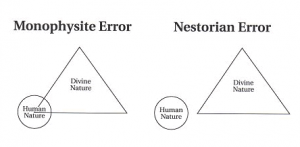
These days, when analytic philosophers of theology talk about the Incarnation, they often say things like ‘if such-and-such, then such-and-such, but that would be Nestorianism’. The implication, of course, is that landing oneself in Nestorianism would be a very bad thing.
But why? Perhaps a lay person might want to avoid Nestorianism because they were told it was a ‘heresy’. But a hard-core Christian philosopher, I think, would want to be more explicit about saying just what Nestorianism is, and provide some reason for why they want to avoid it (rather than just asserting that some position is Nestorian).
So what, exactly, is the philosophical meat and potatoes of Nestorianism? In this series of posts, I want to explain what Nestorianism is from a philosophical point of view. Monophysitism is also thrown around sometime in these discussions, so I will discuss that too.
(Oh, I think there are still thriving ‘Nestorian’ and ‘Monophysite’ (or to use the politically correct term, ‘Miaphysite’) Christian communities out there, but the beliefs of these communities do not necessarily match up with the Nestorian and Monophysite heresies that were condemned by the early church. In these posts, I am only talking about the condemned heresies.)
